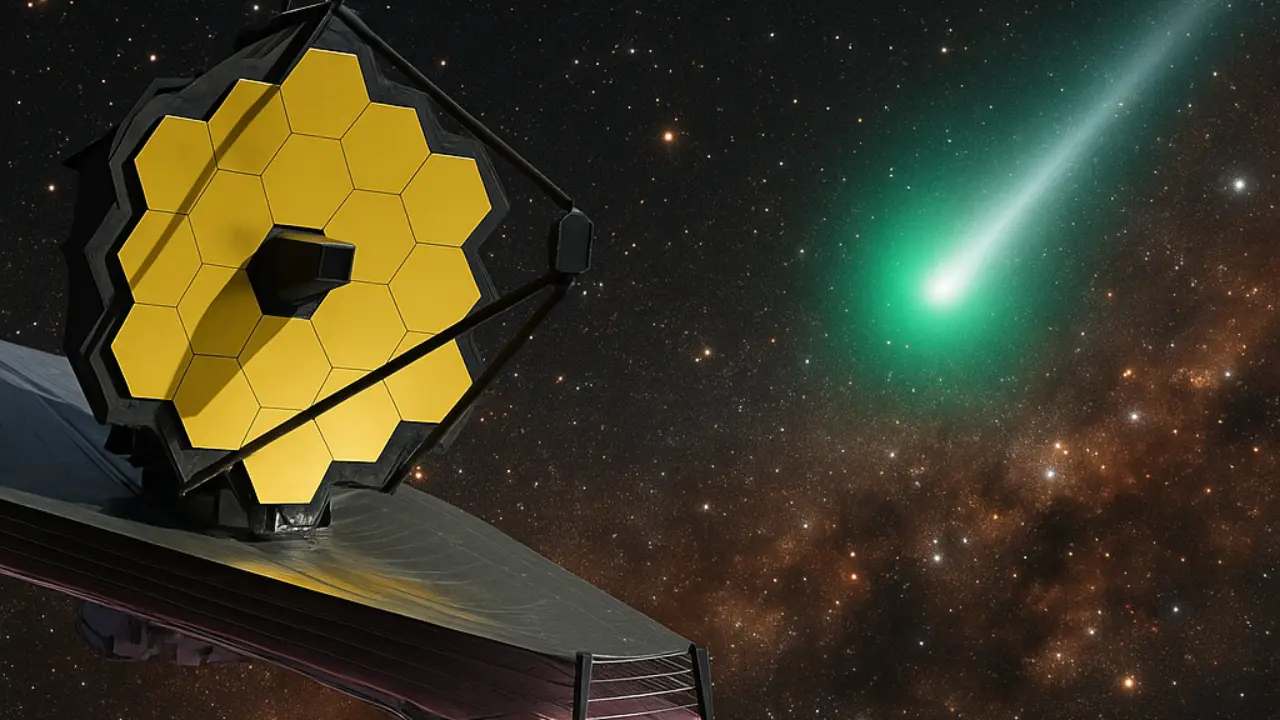The discovery of interstellar objects passing through our Solar System has always sparked a rush of scientific curiosity, but none has generated the level of excitement now surrounding 3I/ATLAS. When the James Webb Space Telescope (JWST) turned its precision infrared instruments toward this newly arrived visitor, the results challenged decades of assumptions about how comets and icy bodies form around distant stars. What JWST found inside the coma of 3I/ATLAS was nothing short of extraordinary: a rich spectrum of exotic compounds, an unusually dominant presence of carbon dioxide, unexpected traces of complex volatiles, and hints of metal vapor rarely observed in such abundance.
These findings are not merely interesting—they may rewrite the chemical story of how planetesimals form beyond our Solar System. Scientists believe 3I/ATLAS carries the preserved fingerprints of the environment in which it originated, offering rare insight into the diversity of planetary formation processes across the galaxy.
This article explores the discovery, chemistry, scientific implications, global telescope campaign, remaining mysteries, and future possibilities unlocked by JWST’s unprecedented observations.
Discovery of 3I/ATLAS
3I/ATLAS was first detected by the Asteroid Terrestrial-impact Last Alert System (ATLAS) in July 2025. The object’s high velocity and hyperbolic trajectory quickly confirmed what astronomers suspected: this was no ordinary comet—it was an interstellar traveler, only the third such object humans have observed. Its predecessors, 1I/ʻOumuamua and 2I/Borisov, had already shown scientists that planetary systems elsewhere produce bodies with noticeable chemical and structural differences. But 3I/ATLAS promised something even more compelling because of its brightness, sustained activity, and ideal position for infrared observations.
Almost immediately after discovery, an international group of observatories began tracking the object. Hubble imaging revealed a large, diffuse coma surrounding a relatively small nucleus. Ground-based telescopes noted unusual gas emissions. But the real breakthrough came once JWST scheduled its August 2025 observation window.
Webb’s unprecedented view
When JWST’s Near-Infrared Spectrograph (NIRSpec) locked onto 3I/ATLAS, the telescope recorded an infrared fingerprint with clarity never before achieved for an interstellar object. Webb’s data revealed:
-
Carbon dioxide as the overwhelmingly dominant molecule in the coma
-
A surprisingly low relative concentration of water vapor
-
Noticeable traces of carbon monoxide, carbonyl sulfide, and cyanide
-
Unexpected signals indicating the presence of nickel vapor
-
A distinctly asymmetrical coma rich in gas and dust
-
Emission patterns unlike those of typical comets in our Solar System
This combination of features immediately set 3I/ATLAS apart from most known comets. In our Solar System, water ice is usually the primary volatile. But 3I/ATLAS appeared to be built on a fundamentally different chemical template.
What Webb found: an unusual chemical profile
The chemical inventory revealed by Webb suggests that 3I/ATLAS formed in a radically different environment. Below is a detailed overview of the compounds identified so far.
Carbon dioxide dominance
The most striking result was the overwhelming abundance of carbon dioxide in the coma. In typical Solar System comets, CO₂ and H₂O appear together, but water usually dominates. With 3I/ATLAS, the roles appear reversed. A CO₂-rich volatile inventory suggests the object could have formed:
-
In a much colder region of its parent system
-
Under different elemental ratios, particularly carbon-to-oxygen
-
In a zone with lower availability of water ice
-
In a disk environment influenced by strong radiation or chemical gradients
Lower-than-expected water content
Although water was detected in both vapor and ice form, its relative abundance was far lower than scientists expected. This contradicts the long-standing assumption that most comets forming beyond the snow line should contain large reserves of frozen water.
Exotic volatiles
The presence of carbon monoxide, carbonyl sulfide, and cyanide compounds adds further intrigue. While all of these appear in some Solar System comets, the proportions in 3I/ATLAS are unusual. Carbonyl sulfide, in particular, provides important clues about sulfur chemistry in its natal disk—a topic with significant implications for prebiotic chemistry.
Metal vapor signals
Perhaps the most debated observation is the detection of nickel vapor in the coma. Nickel and iron are typically found locked inside dust grains and released only under specific thermal conditions. The ratio of nickel to other metals appears unusual, raising questions about whether the parent body experienced variations in temperature, irradiation, or internal differentiation.
Tabular summary of detected species
| Compound or Feature | Detection Method | Relative Abundance | Scientific Importance |
|---|---|---|---|
| Carbon dioxide (CO₂) | Webb IR spectrum | Very high | Suggests cold formation or unique chemical environment |
| Water (H₂O) | Webb and optical telescopes | Moderate to low | Indicates non-typical cometary composition |
| Carbon monoxide (CO) | IR spectroscopy | Moderate | Tracer of extreme cold formation conditions |
| Carbonyl sulfide (OCS) | Near-infrared detection | Trace to moderate | Key sulfur carrier, important for disk chemistry |
| Cyanide (CN) | Ground-based spectrographs | Trace | Provides baseline comparison with Solar System comets |
| Nickel vapor | Ground-based detection | Trace but notable | May indicate unusual thermal or compositional history |
What the chemistry tells us about its origins
3I/ATLAS is more than a comet—it is a messenger from another planetary system. Each chemical component carries clues about the environment in which it formed. Several leading theories are emerging:
Formed far from its host star
The high CO₂ and CO content suggest formation in a region colder than the outer reaches of our own Solar System.
A different carbon-to-oxygen ratio
If the host system’s disk had a higher abundance of carbon relative to oxygen, carbon dioxide production could become more efficient during planetesimal formation.
Post-formation chemical processing
Cosmic rays, ultraviolet radiation, or repeated heating and cooling cycles may have altered the molecular structure of the object’s surface.
Layered or heterogeneous nucleus
It is possible that the portion of the nucleus currently outgassing contains pockets rich in CO₂, while other regions remain hidden below the surface.
Comparison with Solar System comets
3I/ATLAS shares some characteristics with long-period comets, such as a dusty coma and a mixture of frozen volatiles. Yet several features set it apart:
-
Dominant CO₂ release rather than water vapor
-
A mix of exotic sulfur compounds not commonly seen at detectable levels
-
Metal vapor emissions
-
Activity levels difficult to reconcile with typical sublimation behavior
These differences raise the possibility that planetary systems across the galaxy may host far more chemically diverse small bodies than previously believed.
Why interstellar comets are scientifically invaluable
Interstellar objects offer a rare and direct view of material formed around other stars. Unlike exoplanet atmospheres or distant disks, which can only be inferred indirectly, interstellar comets bring their original chemistry directly to us. They allow scientists to:
-
Test whether planet formation follows universal rules or varies widely
-
Understand whether key ingredients for life are common throughout the galaxy
-
Compare Solar System comets to extrasolar equivalents
-
Build models of volatile distribution in young planetary systems
-
Assess how frequently materials are exchanged between star systems
Each interstellar visitor provides a unique data point, making 3I/ATLAS an invaluable opportunity.
Global observation campaign
The study of 3I/ATLAS has become one of the most internationally coordinated astronomical campaigns in recent years. It involves:
James Webb Space Telescope
Primary chemical fingerprinting through its near-infrared spectrograph.
Hubble Space Telescope
High-resolution optical imaging that helped estimate nucleus size and activity patterns.
SPHEREx
Broad-coverage infrared spectral mapping to validate Webb’s findings.
Ground observatories
Institutions such as VLT, Keck, Gemini, Subaru, and numerous radio telescopes provided long-term monitoring, trajectory calculations, and metal emission measurements.
Planetary assets
Mars orbiters and Earth-based radar systems contributed additional positional data.
Together, these instruments created the most comprehensive dataset ever assembled for an interstellar object.
Outstanding mysteries
Despite the wealth of data, major questions remain unresolved:
What is the exact nucleus composition?
We still do not know whether the nucleus is uniform or contains layered pockets of different materials.
Is the nickel vapor signal unique?
Determining whether nickel is disproportionately abundant requires more detailed modeling of dust-grain emissions.
What does the relative absence of water actually mean?
It could reflect true formation conditions or recent surface depletion.
How does 3I/ATLAS compare to earlier visitors?
ʻOumuamua showed no typical cometary activity, while Borisov behaved like a carbon-rich comet. 3I/ATLAS seems to occupy its own category.
What is its parent system like?
Without identifying the star of origin, scientists must reconstruct its birthplace through chemical clues alone.
Broader scientific implications
The implications of Webb’s observations extend far beyond this single object. If 3I/ATLAS is representative of a class of CO₂-dominant interstellar bodies, it would mean that:
-
Planetary systems may form comets with very different chemical templates
-
The diversity of volatiles in the galaxy is far greater than previously believed
-
Water-driven comet activity may be more of a Solar System phenomenon than a universal standard
-
Carbon-rich environments could be more common in some protoplanetary disks
These findings challenge long-standing assumptions and may influence how scientists interpret exoplanet atmospheres, disk chemistry, and early Solar System formation.
Future observations and mission possibilities
Continued multiwavelength monitoring
Astronomers plan to observe 3I/ATLAS as it approaches and retreats from the Sun to determine whether deeper layers reveal different chemistry.
Laboratory experiments
Simulated comet analogs will help interpret the IR spectra and volatile release mechanisms.
Future rapid-response missions
Several proposals suggest launching small, agile spacecraft capable of intercepting future interstellar objects.
Long-term possibility: sample return
Although technologically difficult, a future mission could one day collect and return samples from an interstellar object—providing the most direct insight into extrasolar chemistry ever achieved.
Conclusion
The James Webb Space Telescope’s observations of 3I/ATLAS have opened a new chapter in the study of interstellar objects. With its unusual CO₂-rich chemistry, hints of exotic volatiles, and detectable metal vapor, this object stands apart from any comet previously studied. Each molecule detected tells a story, offering clues about the environment where the object was born—somewhere far beyond the Sun, in a star system we may never identify.
As scientists continue to analyze Webb’s data and refine their models, one thing is clear: 3I/ATLAS has provided one of the most detailed chemical windows into another planetary system ever obtained. Its discovery expands our understanding of planetary diversity, challenges existing theories, and underscores the importance of interstellar visitors as invaluable messengers from other worlds.






Leave a Comment